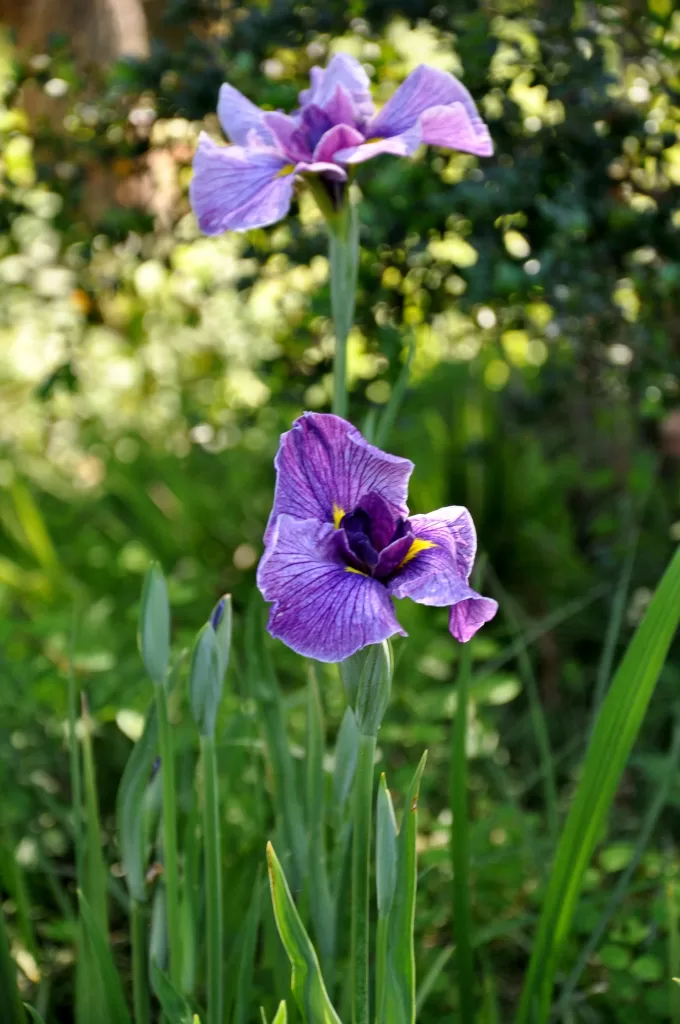Kyoto’s Magnificent Iris Bloom Season
Overarching Bloom Timeline
Kyoto, a city renowned for its gorgeous and ancient temples, has an annual schedule as colorful as its history. Thanks to distinct seasonal variations, every month in Kyoto manifests itself differently in its gardens, mountains, and rivers. The typically quiet month of June signals the arrival of the Japanese Irises’ bloom season.
This timeline isn’t confined to exact dates. It extends from late May to early July. This should be on your list of must-see Kyoto events in May.

Traditional Summer Plants
Iris is considered an iconic summer plant in Japan. Its significance traces back to historical Japanese poetry, known as waka. This traditional form of literature often reflected Iris’s summer moodiness.
Yamashina Ward: Noteworthy Iris Gardens
One cannot discuss the bloom without mentioning significant locations. Located in the eastern part of Kyoto city lies the Yamashina Ward, full of breathtaking Iris gardens known as “Kakitsubata”. This area is immensely popular among locals and tourists alike during the blooming season.
Taizo-In Temple garden
The most famous Iris garden in Yamashina Ward is no doubt the garden of Taizo-in temple. Bestowed upon countless awards for its magnificent display of “Kakitsubata”, visitors can admire a massive variety of approximately 1000 species available there.
Heian Shrine Garden
Another prominent location featuring seasonal irises is Heian Shrine’s Garden. Here, the grassy marshland next to the key bridge gets dense with purple-blue flowers, surrounded by Japanese garden landscaping and traditional pavilions.
Ota Shrine Garden
Situated on the eastern side of Kamigamo Jinja – one of Kyoto’s oldest and most significant Shinto shrines – this shrine embodies an exceptional blend of nature and spirituality.
Boasting the oldest iris pond in Kyoto, Ota Shrine’s rich history is a testament to its enduring significance in maintaining the city’s cultural and floral heritage. The beauty of these irises captivates visitors, making it one of the most popular iris viewing spots in Kyoto.
Hybrid Varieties at Meiji Shrine Outer Garden
Innovative horticulturists created new breeds of Japanese Irises by combining native species with others from China in the Edo Period (1603–1867). These vibrant hybrid varieties are on display at Meiji Shrine Outer Garden, from early to mid-June.
The Significance Behind Irises
In Japanese culture, irises represent nobility and elegance due their unique shape which has long been appreciated by Japanese poets and artists alike. Irises are said to ward off evil spirits and bring good luck.
Special Events during Bloom Season
During iris bloom season, many facilities hold events such as ‘Yomogi Festival’ at Mimurotoji Temple where visitors can enjoy hand-picking yomogi (mugwort) to make ancestral balls called Kusadango.
Furthermore, Meiji Shrine’s iris festival sees traditional entertainment such as Yabusame (horseback archery), tea ceremonies with Wagashi sweets shaped like irises.
Guided Tours for a Complete Experience
Several tour companies offer personalized tours enabling tourists to fully embrace this spectacle.
If you’re looking for a captivating natural spectacle, take advantage of the enchanting Wisteria in Kyoto. Walk through stunning trellises and even tunnels of these climbing vines, adorned with cascades of purple, white, pink, and violet flowers that sway delicately in the spring breeze.